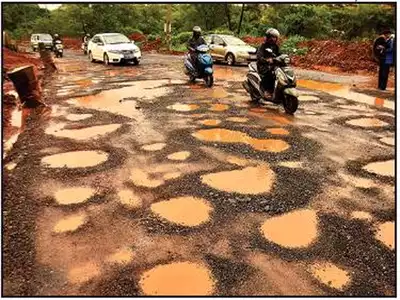Written by a Concerned Citizen living in Goa and edited by Jhatkaa
Goa, India’s most preferred tourist destination with annual tourist footfalls of anywhere up to 3 million (as of 2022), has consistently resolved to give tourists a memorable vacation and tons of GigaBytes for their social media. With a total area of just 3700 sq km, Goa has a road network spanning approximately 18,697 km ( as per 2019 data).
However, there’s a recurring problem – the condition of the roads, especially in the coastal belt with high volumes of 2, 4-wheeler traffic along with public minibuses and, of course, the heavy trucks involved in the widespread private residential and commercial construction projects, is worse than ever before.
The heavy monsoon showers from June through September every year, coupled with the topography of the coastal belt, wreak havoc on the roads, riddling them with potholes and entire sections of the roads, caving in or getting severely eroded. While most of Goa remains free of prolonged water logging during the rains, this has changed over the past few years.
Sign the petition to demand better roads.
Basics of Road Erosion
The road laying and repair methodology currently relies on Asphalt, which uses an oil-based substance called bitumen to make sand and crushed rock stick together like glue. After the asphalt is heated to about 150° C, it is moved to the construction site. Construction crews spread and compact it onto the foundation already in place there. Hence, the quality of the bitumen being used, the care taken during the process, and the temperatures are all critical in establishing the longevity of the roads. Furthermore, the asphalt thickness is typically supposed to be 4 to 8 inches. It’s anybody’s guess how these parameters are measured, controlled, and implemented.
India’s preferred road-laying material has long been bitumen, while most of the world’s developed nations use Concrete roads. The paving cost of concrete roads is higher than that of bitumen roads. But the cost is justified because of its durability. So perhaps as we step into the future, as a leading state of India in development indices and as a counter to the yearly monsoon rains, Goa needs to reconsider the use of Bitumen for construction and repair of its roads.
If the process is done correctly and with the right materials, the roads will resist erosion by rain and the passage of vehicles. A new, well-built asphalt road should last at least 15 years before a major rehabilitation or full-depth reconstruction is needed. However, surface treatments or thin overlays every 7-10 years can extend that to 20 years between major work. However, the potholes and erosion often commence within a few months of the road works, only accelerated by the rains (seasonal and unseasonal).
Support change here.
What’s Causing the problem?
The deterioration of roads is potentially due to the following factors or a combination thereof:
- Use of substandard materials and poor adherence to the process specifications.
- Lack of curing or rest time for the materials to bond and cure.
- Large scale and persistent erosion by rainwater runoff, especially in the areas that have a gradient (no matter how small the gradient is – remember gravity makes water flow and water has mass and water carries along small stones, gravel, rocks and even boulders, which effectively become very effective sandpaper when debris-laden water flows over poorly designed and constructed roads)
- No design or thought given to the drainage of rainwater runoff adjoining the road.
- Rainwater drains fill up with garbage, plants and general roadside dust and stones, depleting their runoff-carrying capacity and resulting in “rivers and streams” flowing on and across the roads.
- Illegal blocking of rainwater drains by houses and construction projects, especially to carve out illegal parking areas by the side of the roads.
- Sanctioned and illegal digging of roads for laying cables and pipes and filling them up with loose mud and stones once the job is completed – without any govt oversight or contractor’s responsibility.
Is lack of road maintenance akin to Causing death by negligence?
The danger these road conditions pose for the permanent and temporary residents of Goa is appalling, to say the least, since 8- to 12-inch-deep potholes on poorly lit roads can kill people! And we’re not even talking about rash driving or overspeeding! The loose gravel on the roads and the omnipresent potholes force vehicles to swerve left and right to avoid them, with imminent danger of accidents from oncoming and following traffic.
Besides the critical danger to human life and health, the roads also seriously affect private vehicle suspension, tyres and chassis, leading to increased maintenance costs for ordinary tax-paying citizens! The writers of this article have personally experienced small, pointed gravel stones causing tyre tears, bursts and punctures (remember, not metallic nails … but gravel polished to sharp points by rain and construction activity).
Imagine the consequences for the elderly or pregnant women on a 2-wheeler if they were to fall and get hit by following or oncoming traffic. It’s evident that the non-maintenance of roads by the concerned department, Ministry and ultimately the government in power is nothing but culpable homicide, not amounting to murder.
Perhaps the right to well-engineered motorable roads must be included as a fundamental right nationwide.
Is there a solution?
While one can wax eloquent about the strides India has made in indigenous capability development and landing on the moon – it’s an unfortunate and regrettable situation regarding the road conditions.
Here are certain solutions that require action at the government, local body, and citizen levels:
- Non-maintenance of roads and failure by contractors to make an offence in the state due to the danger it poses for human life. “Causing death by negligence” must be drilled down every contractor and agency’s mind.
- Clauses in the contract while offloading road maintenance or road laying work to contractors should include:
a) Independent checks of the material being used.
b) Warranty clause on the longevity of the roads.
c) Re-check the area’s rainwater drainage system (along the roadsides) and its proper repair, upkeep, and maintenance to be included in the scope of work.
d) Ordinate residents of the area, including but not limited to local panchayat, to be roped in for signing the completion certificate of the road works.
e) Part of the payment will be made to contractors only post-passage of the next monsoon season to ensure accountability.
f) Payment to contractors for digging of roads for approved cable/pipe laying is to be made only after signatures of local panchayat or ordinary residents regarding the “restoration” of the dug-up area. After all, the taxpayer’s money literally gets washed down to the sea with every monsoon.
3. The use of plastic bottles and waste should be encouraged in road re-laying and maintenance. Bangalore has shown the way in using millions of plastic bottles for road repair and construction.
4. Involve experts from IIT Goa and other higher education institutions and research candidates to propose novel and eco-friendly methods to prevent rainwater erosion of roads in Goa.
5. Initiate a Govt WhatsApp group where people can share photos and locations of potholes and bad stretches – with a robust follow-up mechanism. The country’s IT skills are more than sufficient to design a back end for this WhatsApp-based group, which can categorise road repairs based on locality and severity of potential accidents, and weekly reports and status be made available online regarding the repair work. This might sound far-fetched, but the world’s third-largest economy may well embark on these citizen initiatives and win the trust of the electorate.
6. Levy a substantial charge or tax on heavier vehicles (heavy construction trucks, large tourist buses) that intend to ply on residential or smaller roads to offset the cost of repairs on roads damaged due to heavy loads.
7. Levy a smaller charge or tax on all tourist vehicles entering Goa (strictly for non-permanent residents of Goa/tourists) – this smaller amount can be paid online with an online receipt. Funds so received to be utilised for road works.
8. Make housing construction projects responsible for ensuring approach roads are not damaged by the rain and gravel runoff from the construction sites. It’s easy to spot the importance of this aspect – just see the damage to existing roads that are located near construction sites (especially if the site is at an elevation relative to the road). Stone and gravel mixed with rainwater runoff causes deep erosion of the roads.
9. Employ Road mechanical cleaners Post every monsoon to remove all loose gravel, stones and dust from existing roads to improve their longevity. It’s high time that the authorities take the issue much more seriously and set up urgent measures to address the above-mentioned concerns.
Sign the petition to drive change in Goa!


